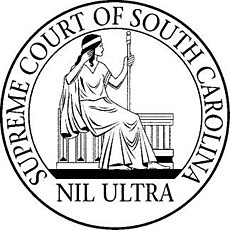Supreme Court of South Carolina
| Supreme Court of South Carolina | |
|---|---|
 |
|
| Established | 1841 |
| Country |
|
| Location | Columbia |
| Motto | "NIL ULTRA" |
| Composition method | Election by the General Assembly |
| Authorized by | S.C. Const. art. V, §§ 1-2 |
| Decisions are appealed to | Supreme Court of the United States |
| Judge term length | Ten years, staggered |
| No. of positions | 5 |
| Website | Supreme Court |
| Chief Justice | |
| Currently | Donald W. Beatty |
| Since | February 1, 2017 |
|
Supreme Court of South Carolina Building
|
|

Supreme Court of South Carolina Building, December 2009
|
|
| Location | 1231 Gervais St., Columbia, South Carolina |
|---|---|
| Coordinates | 34°0′6″N 81°1′57″W / 34.00167°N 81.03250°WCoordinates: 34°0′6″N 81°1′57″W / 34.00167°N 81.03250°W |
| Area | 0.5 acres (0.20 ha) |
| Built | 1917–1921 |
| Architect | Gill & Wilkins; Andrew V. Kerns |
| NRHP Reference # | 72001220 |
| Added to NRHP | October 18, 1972 |
The South Carolina Supreme Court is the highest court in the U.S. state of South Carolina. The court is composed of a Chief Justice and four Associate Justices.
Judges are selected by the legislature of South Carolina to serve terms of ten years. There is no prohibition against justices serving multiple terms on the court. However, there is a mandatory retirement age of 72 for state trial judges and state appellate judges in South Carolina.
For a list of previous justices see List of Justices of the South Carolina Supreme Court.
The court enjoys both original and appellate jurisdiction. It enjoys exclusive appellate jurisdiction for all state cases regarding the death penalty, state utility rates, judgments involving public bonded indebtedness and elections, and orders limiting state grand juries and relating to abortions by minors. Original jurisdiction pertains to the issuance writs including mandamus, certiorari, and very extraordinary bills.
The South Carolina Supreme Court oversees the admission of individuals to practice law in the state. Much of the administration regarding admissions and practice is delegated to the South Carolina Bar, established by statute as an administrative arm of the court; however, the court retains ultimate authority in South Carolina governing the practice of law. It also supervises the disciplining of attorneys and suspension of those no longer able to practice due to mental or physical condition.
The Supreme Court of South Carolina Building is located in the state capital of Columbia. The court moved into its current location, a former United States Post Office building, in 1971. It was built between 1917 and 1921, and is a two-story, Neo-Classical style building. The building has been listed on the National Register of Historic Places since 1972. Prior to 1971, the court met in a section of the South Carolina State House in an area totaling approximately 1,400 square feet (130 m2); the justices did not have individual offices, but instead met in a common conference room when not presiding over a session of court.
...
Wikipedia


